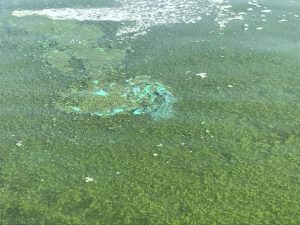Toxic Algae: Identifying and Reporting HABs
As summer temperatures rise, more and more Idahoans take to the water to beat the heat. But soon, they won’t be alone—toxic algae will also be taking to the water this summer, making reservoirs, lakes, and rivers unsafe for swimming.From our recent blog on the basics of toxic algae, we know that blue-green algae or cyanobacteria naturally occur at background levels in many freshwater ecosystems. But when there’s a combination of high water temperatures and excessive pollutants, this algae can grow out of control and produce toxic outbreaks. When this happens, the water isn’t safe for people, pets, or wildlife. The Idaho Department of Environmental Quality (IDEQ), local Health Districts, and others rely on citizen reports to monitor algae outbreaks, so it’s important for all Idahoans to know what one looks like.So, the question is how does one know what an algae outbreak looks like and how should they report it?
What does an algae outbreak look like?
Cyanobacteria can vary in appearance – often it looks bright green (like pea soup), but can range in color from blue to brown, red, or even white. Here are simplified instructions on how to identify toxic algae in the field: https://extension.usu.edu/utahwaterwatch/ou-files/HABs/Simplified-HAB-Field-Identification-Instructions-2021-update.pdf.Outbreaks sometimes look like grass clippings, spilled paint, foam, or can appear mat-like, forming a dense surface scum. If you see algae while out on the water, you can do a simple stick test to rule out a couple of common (and non-toxic) types of algae. Find a sturdy stick or pole and pull it through the algae. If the stick pulls out strands that look like green hair or threads, the mat on the pond is likely filamentous green algae (non-toxic). Likewise, if you pull out duckweed, tiny aquatic plants with a grainy texture, then you are likely not looking at an outbreak of toxic algae. If you’ve ruled out those two options, then the algae could in fact be toxic and warrants further investigation by professionals. 
Who should I contact if I suspect an algae outbreak?
Notify the IDEQ promptly to initiate monitoring efforts to determine whether an outbreak is present and a Health Advisory is warranted.To report a potential harmful algal bloom, use one of the methods below. Make sure to note the date/time, location, photos, and descriptions:
- Online form
- Phone: (866) 671-5385
- Email: algae@deq.idaho.gov
Information about active health advisories and potential algae outbreaks is available online through the Idaho Department of Health & Welfare and Idaho Department of Environmental Quality.If you notice a suspected outbreak, it’s important to stay out of the water. If you, your pets, or other individuals have been in contact with the water, seek out clean water to wash off. Watch closely for any potential symptoms and seek prompt medical attention if you develop any. Symptoms can include abdominal pain, vomiting, blistering around the mouth, fever, headache, diarrhea, cough, hives, rashes, and respiratory paralysis. Toxic algae can even lead to death.While the State relies upon citizen reports to monitor potential algae outbreaks, there’s more that can—and needs—to be done. The Idaho Department of Health & Welfare is currently responsible for issuing health advisories when IDEQ’s water sampling indicates a toxic algae outbreak. However, neither of these agencies receives any funding to proactively monitor, manage, or prevent these potentially deadly outbreaks. Help combat toxic algae by taking action below, and call on the Governor’s office and IDEQ to ensure dedicated funding is made available to address this public health hazard and take meaningful steps to monitor for outbreaks, keeping people, dogs, and livestock safe from the dangers posed by toxic algae.
Plus, dive deeper into the world of toxic algae in Idaho by attending our upcoming Toxic Algae Webinar on May 30 from 6-7pm. ICL will be joined by Dr. Amie Parris of IDEQ for a presentation on toxic algae outbreaks, what causes them, what the risks are, how you can stay safe, and what we’re doing to help. Toxic algae affects waterways and Idahoans all over the state, so make sure to tune in! Register here: https://us02web.zoom.us/webinar/register/WN_8Wl_wUj8Rm2EGnLpEAfQHg#/registration

